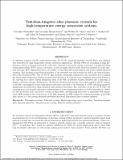Tantalum-tungsten alloy photonic crystals for high-temperature energy conversion systems
Author(s)
Stelmakh, Veronika; Rinnerbauer, Veronika; Soljacic, Marin; Chan, Walker R; Senkevich, Jay; Joannopoulos, John; Celanovic, Ivan L.; ... Show more Show less
DownloadSoljacic_Tantalum-tungsten.pdf (1.178Mb)
PUBLISHER_POLICY
Publisher Policy
Article is made available in accordance with the publisher's policy and may be subject to US copyright law. Please refer to the publisher's site for terms of use.
Terms of use
Metadata
Show full item recordAbstract
A tantalum tungsten (Ta-W) solid solution alloy, Ta 3% W, based 2D photonic crystal (PhC) was designed and fabricated for high-temperature energy conversion applications. Metallic PhCs are promising as high performance selective thermal emitters for solid-state thermal-to-electricity energy conversion concepts including thermophotovoltaic (TPV) energy conversion, as well as highly selective solar absorbers/emitters for solar thermal and solar TPV applications due to the ability to tune their spectral properties and achieve highly selective emission. The mechanical and thermal stability of the substrate was characterized as well as the optical properties of the fabricated PhC. The Ta 3% W alloy presents advantages compared to the non-alloys as it combines the better high-temperature thermo-mechanical properties of W with the more compliant material properties of Ta, allowing for a direct system integration path of the PhC as selective emitter/absorber into a spectrum of energy conversion systems. Furthermore, the thermo-mechanical properties can be fine-tuned by the W content. A 2D PhC was designed to have high spectral selectivity matched to the bandgap of a TPV cell using numerical simulations and fabricated using standard semiconductor processes. The emittance of the Ta 3% W PhC was obtained from near-normal reflectance measurements at room temperature before and after annealing at 1200°C for 24h in vacuum with a protective coating of 40nm HfO2, showing high selectivity in agreement with simulations. SEM images of the cross section of the PhC prepared by FIB confirm the structural stability of the PhC after anneal, i.e. the coating effectively prevented structural degradation due to surface diffusion.
Date issued
2014-04Department
Massachusetts Institute of Technology. Institute for Soldier Nanotechnologies; Massachusetts Institute of Technology. Department of Electrical Engineering and Computer Science; Massachusetts Institute of Technology. Department of PhysicsJournal
Proceedings of SPIE--the International Society for Optical Engineering
Publisher
SPIE
Citation
Stelmakh, Veronika, Veronika Rinnerbauer, Walker R. Chan, Jay J. Senkevich, John D. Joannopoulos, Marin Soljacic, and Ivan Celanovic. “Tantalum-Tungsten Alloy Photonic Crystals for High-Temperature Energy Conversion Systems.” Edited by Sergei G. Romanov, Gabriel Lozano, Dario Gerace, Christelle Monat, and Hernán R. Míguez. Photonic Crystal Materials and Devices XI (May 2, 2014). © 2014 Society of Photo-Optical Instrumentation Engineers (SPIE)
Version: Final published version
ISSN
0277-786X